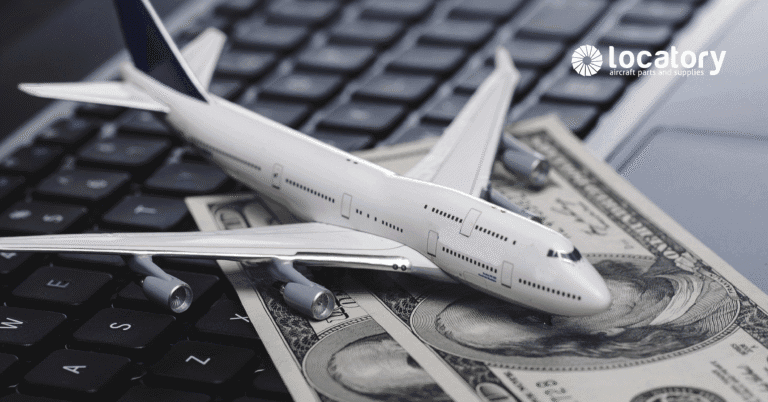- Aircraft parts pricing is shaped by complex supply chains, regulatory requirements, and operational urgency, with costs varying widely by condition, traceability, fleet age, and whether components are new, overhauled, or serviceable.
- Critical systems — from hydraulics and electrical units to fasteners and cabin interiors — carry significant and often escalating costs, driven by certification standards, limited production volumes, and the rising maintenance needs of ageing fleets.
- Digital procurement and booking platforms, exemplified by partnerships like United Cargo and cargo.one, are accelerating adoption of online pricing and booking, enabling forwarders to boost efficiency, expand reach, and respond more effectively to global parts demand.
Behind every safe flight, every scheduled departure, and every cargo delivery, there’s a silent yet vital economy in motion — the aircraft parts market. It’s a world where a single component can ground an aircraft, delay an operation, or cost tens of thousands of dollars to replace. And it’s not just engines or flight computers we’re talking about. Even the most unassuming part, such as pressure sensor, a fuel pump, or a bolt, can trigger a cascade of additional costs if it’s not readily available or properly priced.
One operator’s surplus is another’s AOG nightmare. The older the plane, the deeper the hole.
But what determines the cost of an aircraft part? And why does the same component sometimes vary so drastically in price, depending on condition, region, or operator? Is it just about the brand and part number — or are there deeper forces at play, such as global supply chains, aircraft age, or regulatory pressure? In recent years, freight forwarders of all sizes have realised the benefits of digital procurement and sales. Expanding networks and investment in more agile services give forwarders the edge to quote faster, win more business, and scale globally. In a co-ordinated push, carriers, forwarders, and digital booking platforms are collaborating to unlock further growth with digital tools.
As digital bookings in many markets already exceed offline bookings, the industry is looking at strategies to further accelerate adoption, and partnerships like that of United Cargo and cargo.one are leading the charge.
By using digital marketplaces for their pricing, quoting and booking, forwarders can reach new benchmarks for efficiency, responsiveness, and growth.
Over the past year, United Cargo and cargo.one have grown bookings together, particularly in EMEA and North America. The growth was accelerated by the integration of cargo.one into the in-house operations tools of many of the world’s largest forwarders, powering their digital workflows.
The hidden costs of keeping aircraft in the sky
When most people think of aviation costs, they picture fuel prices, pilot salaries, or maybe airport fees. But the real complexity (and a major share of operational expenditure) lies beneath the surface: in the tens of thousands of components that make up an aircraft.
From commercial airliners and business jets to helicopters and cargo planes, every flight depends on the reliability and availability of parts that are sourced, installed, and replaced on a constant basis. A single narrow-body aircraft may contain close to a million individual parts, ranging from fasteners worth mere cents to avionics modules that cost more than a luxury car.
And with aircraft ageing and fleets diversifying, the challenge of managing these costs has grown more intense than ever. Understanding what these parts actually cost — whether they’re new, used, or overhauled — has become critical not just for procurement teams, but also for maintenance planners, asset managers, and CFOs trying to make data-driven decisions.
The marketplace behind every flight
Aviation runs on parts, and parts run on supply chains. Yet those supply chains are anything but straightforward. Aircraft parts are not produced at scale like consumer electronics; instead, they are made in controlled quantities under rigorous certification standards.
They’re tracked from birth to retirement, logged in serialised systems, and governed by regulatory frameworks that span continents. All of this adds complexity — and cost. For example, a component that costs US$540 to manufacture might sell for US$5,400 due to its critical role, certification requirements, and limited availability. And that’s just the beginning. Aircraft parts pricing is influenced by a dizzying array of factors: the platform they’re designed for, the fleet age, whether the OEM still supports the part, recent ADs (Airworthiness Directives), seasonal AOG surges, and more. It’s a supply-and-demand model with serious real-world consequences.
Why the same part can cost different prices
It’s one of the most frustrating realities in aviation logistics: two buyers can purchase the same part, and one might pay 50 percent more. Why? Because in aviation, price is not just about the part. It is also about its condition, traceability, origin, availability, and delivery timeline. A brand-new OEM part shipped directly from the manufacturer carries the highest premium, especially if it’s in short supply.
But that same part, if it’s available used in serviceable condition or freshly overhauled with FAA/EASA dual release, might cost significantly less, and still meet all regulatory requirements. The price also fluctuates based on whether the part is covered by warranty, its time since overhaul (TSO) or cycles remaining, and whether it’s accompanied by a full trace.
Then there’s urgency. A component sourced for scheduled maintenance months in advance might be priced modestly, while the same part ordered AOG with same-day shipping could come at a steep markup. The differences aren’t arbitrary. They reflect real economic and logistical pressures. That’s why a part that theoretically costs US$3000 can fetch anything from US$1,500 to US$6,600, depending on context.
Three tiers of cost, three layers of risk
In the aircraft parts world, the condition of a part is not just a technical detail—it’s a core pricing determinant. At the top of the pyramid sit brand-new, OEM-supplied components: the gold standard in terms of documentation, reliability, and manufacturer support. These come with full traceability, warranty, and often a steep price. For high-value systems, like avionics modules or hydraulic actuators, buying new can mean paying double compared to an overhauled unit. But new isn’t always better, especially when timing and budget come into play.
That’s where repaired and used serviceable parts enter the equation. A part that’s been removed, inspected, and certified as serviceable might be priced 30 percent to 60 percent lower than new, depending on how much life remains. Overhauled parts, meanwhile, typically sit in the middle — refurbished to near-new condition and recertified by licensed repair stations. Many operators strategically combine these options, sourcing new parts for critical systems while relying on rotables and repaired components for less sensitive areas. It’s not just a question of cost, but of balancing airworthiness requirements, availability, and time sensitivity.
Small but mighty: Fasteners and fittings
It’s tempting to overlook the value of the small stuff. After all, how much can a bolt cost? In aviation, quite a bit. Take the case of high-strength titanium fasteners used in pressurised structures: they may look like common hardware-store screws but are priced anywhere from US$10 to US$100 each, depending on their material, tolerance, and traceability.
Multiply that by the thousands of fasteners on each aircraft, and suddenly this category becomes a significant budget line. Fittings, bushings, rivets, clamps — all are manufactured under rigorous aerospace standards and often come with serialised trace documentation. And when these parts are ordered on an AOG basis, expedited handling can double the price.
Electrical systems and their price tags
Electrical components might not have the visual impact of engines or control surfaces, but they’re just as critical to flight operations. Generators, converters, wiring harnesses, relays, and circuit breakers — each is essential, and each comes with a cost tied to both engineering complexity and service criticality. For instance, an auxiliary power unit (APU) starter-generator might cost US$8,000 in overhauled condition or more than US$20,000 brand new. Battery control units, transformers, and even aircraft batteries themselves carry similar premiums.
Aging fleets often need more frequent electrical replacements, and as aircraft systems become more digital, the parts themselves become more specialised and expensive. The added challenge is that many of these parts have short replacement cycles or are subject to high wear, making them a regular feature in MRO operations. Pricing transparency in this category is essential for budgeting, especially for low-cost carriers where margins depend on tight control over maintenance expenses.
Hydraulics and flight control systems
Flight controls, such as flaps, rudders, and elevators, don’t move themselves. Behind the scenes, a complex system of hydraulic pumps, actuators, control valves, and reservoirs translates cockpit inputs into physical movements. These systems are complicated, powerful, and, unsurprisingly, expensive. A single elevator actuator for a narrow-body aircraft like the Boeing 737 NG can cost over US$100,000 when new, while refurbished options may bring the cost down to around US$40,000–US$60,000.
Hydraulic systems also require regular inspection and flushing, with parts like pumps and accumulators needing replacement or overhaul during scheduled maintenance intervals. Costs add up fast, especially when dealing with older aircraft where newer parts may not be supported by OEMs, and aftermarket options are scarce. Locatory.com users frequently search for flight control and hydraulic components not only based on cost, but also based on remaining service life, previous repair records, and shipping proximity — all factors that affect how soon that aircraft can return to the sky.
The cabin economy
Passenger comfort might not be the first thing that comes to mind when you think about aircraft maintenance costs, but the interior can represent a surprisingly large part of a parts budget. Take economy seats, for instance. Basic models cost around US$3,000–US$6,000 each when new, while lie-flat business class seats can range from US$30,000 to US$75,000 per unit. Add in-flight entertainment systems, window panels, sidewall linings, galleys, and lavatories, and the cabin becomes a highly customised, modular system where every component has a price.
What’s more, interior parts often need replacement due to wear and tear, regulatory changes, or branding updates. Airlines doing cabin retrofits must budget accordingly — and find suppliers who can meet both volume and aesthetic requirements. On Locatory.com, interior parts are among the fastest-moving categories, especially from airlines that are sunsetting older fleets and selling off surplus parts to newer operators or refurb shops.




